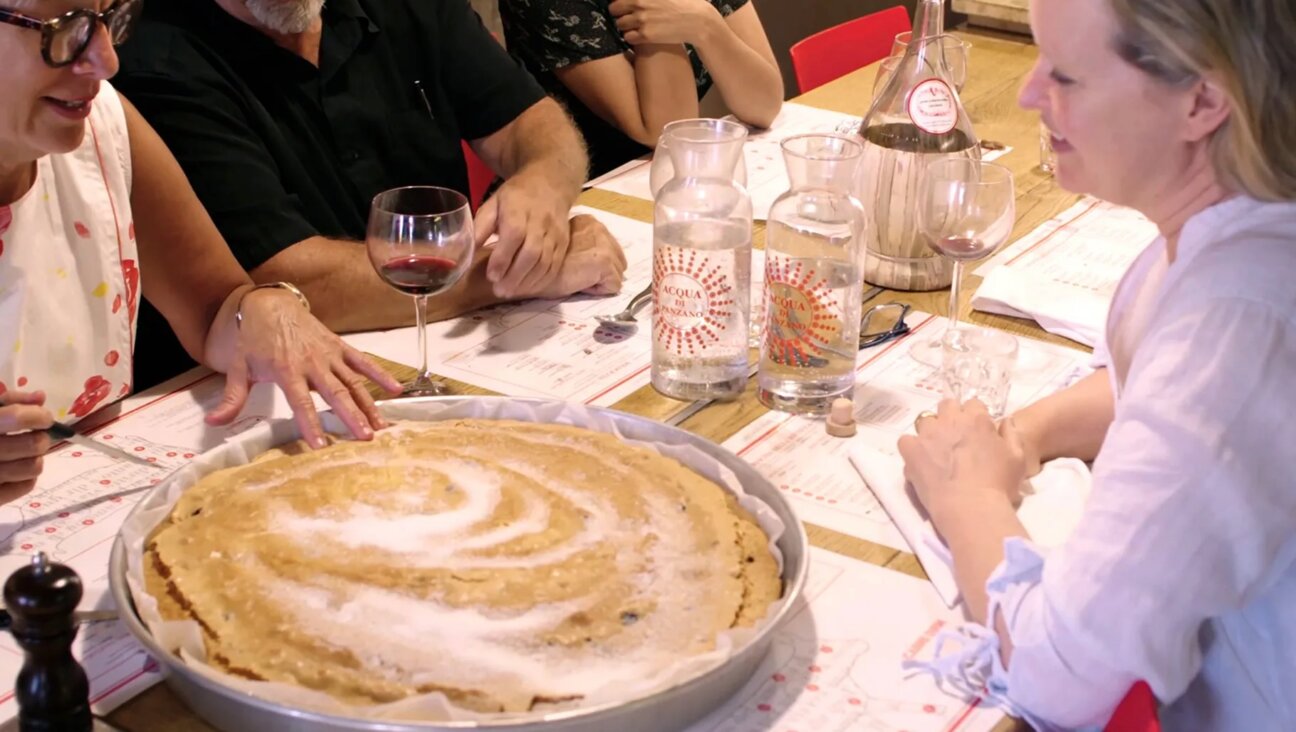Fresh Zesty Dandelion Salad

Graphic by Angelie Zaslavsky
Once considered nothing more than a pesky weed, it is now a gourmet green. Just take a look at the four delicious dandelion-green recipes below.
Even though we now live near a supermarket after years in the remote countryside, we still strive to grow as much of our food as we can and we still enjoy the thrill of harvesting it from the wild. We look forward to dandelion season, not only because we crave something fresh after a winter of stored vegetables, but because we associate collecting their edible leaves with spring renewal.
To us, their tangy flavor in raw, wilted and cooked dishes is synonymous with the fresh things that comes from the earth when the snow melts, the soil warms and we are reconnected to the living land.
Decades ago when we lived in northern Vermont, digging for dandelions was still a spring ritual, motivated by the age-old longing in cold countries where winter is severe, to add a bit of fresh greens to the table after a prolonged diet of stored vegetables. In our area, women could be seen in the green fields in classic images of harvesting, their bodies bent, their arms reaching down to the earth.
The greens they dug with a sharp knife and carried home in paper bags were boiled with a piece of salt pork, a dish savored by country folk. Although this rustic tradition, with its roots buried deep in the past, has largely vanished with the availability of fresh foods year round, dandelion greens have taken on new glamour as a desirable gourmet green, a result of the food movement that began in the 1970s, and has been growing in force ever since.
A large part of that force is attributable to Freida Rapoport Caplan, founder in 1962 of Frieda’s Specialty Produce, a wholesale company based in California whose slogan is “Changing the Way America Eats Fruits and Vegetables.” Fresh produce we now take for granted such as kiwi fruit, Habanera chile peppers, Asian pears, pine nuts and a zillion other things, were introduced via Freida’s, which distributes its produce, including cultivated dandelion greens, to supermarkets and wholesalers across North America. As an undeniably real, authentic food, dandelion greens turn up in Whole Foods stores and similar outlets. But if you can’t find them there, then look for them in Italian groceries or your local supermarket.
Several years ago when I last checked, ours featured two types, the usual long leaf and a shorter, head type. According to the produce manager, bunched dandelion greens had been popular with customers for at least the last ten years. “People want fresh greens,” he told me, “to use in stir fry dishes and salads.” The dandelion greens I saw were crisp, green and fresh — and if I hadn’t been a confirmed forager, I might have purchased these on the spot.

Taraxacum officinale
Taraxacum officinale has a long history as a valued medicinal and as a nutritious food. It is also a ubiquitous weed. Whether we want them or not, dandelions turn up in disturbed ground throughout the entire northern hemisphere, most obviously in enriched garden soil and lawns, but also in pastures, roadsides and in the proverbial waste places. Perennial plants grow from a tenacious, hard taproot, white inside and brown without, from which sprout jagged, dark green basal foliage, tangy and refreshingly bitter at first, aging to decidedly bitter.
By late spring bright, fluffy yellow flowers bloom from hollow stems followed by fluffy fruits dispersed by the wind over vast areas, thus assuring the establishment of ever more plants. The genus name may be based on the Greek taraxo, “I have cause,” and achos, meaning pain, a reference to the plant’s long history as a healing herb. The species name, officinale, attests to its role as an approved herb of the apothecary (or drugstore, in modern parlance). The common name “dandelion” is a corruption of the Old French for “tooth of a lion,” a rather fanciful description of the plant’s jagged-edge leaves.
Bitter properties, dispersed throughout the plant, but most powerfully present in its roots, are responsible for its vast curative powers, first recorded by an Arabian doctor in the tenth century. Dandelions make a potent diuretic, for which they earned the country name “piddley bed.” Preparations in the form of decoctions, tinctures and teas from the plant’s roots and leafy tops are used to treat kidney and liver disorders, and to increase mobility and reduce stiffness in cases of degenerative joint diseases. By removing poisons from the body — as in their proven role as a diuretic — dandelion preparations also act as a tonic and stimulant.
Nutritionally, dandelions are a powerhouse plant. Low in water content but rich in protein, sugar, vitamins A and C, calcium and other minerals, their leafy greens are at the top of the list of valued edible weeds. They rank higher than lettuce (cos or romaine) in protein, carbohydrates, calcium and iron, and much higher in nearly all vitamins and minerals. Traditionally featured in Italian pasta dishes, in contemporary cooking dandelion greens are mainly featured in salads and in stir fry dishes as a substitute for broccoli rabe or rapini, a mustardy, sweet form of turnip green.
There are alternatives to buying dandelion greens in the supermarket. You can grow them in the garden just like lettuce. There are two strains most readily available. Thick-leaved Improved, 95 days to maturity, is reported to be slower to bolt than other types. It may be marketed as Dandelion Ameliore, which means “improved dandelion.” French Dandelion or Vert de Montmagny, 92 days to maturity, is more compact, with finely cut dark green leaves and large hearts.
You need never worry about a crop failure, though, if you forage for dandelion greens. Look for them not in lawns or fields but in rich soil where the ground is deep, porous and humusy, as in a garden. Eating them is the perfect way to get rid of them!
To harvest: Take a stout sharp knife and plunge it straight down next to the young green leaves until you reach the plant’s crown. Cut across, slicing the crown from the root, but leave the dandelion bunch intact to facilitate cleaning. Shake out each bunch as you cut it to loosen dirt and debris; then pull off the outside damaged or yellow leaves. Swish the bunch through several buckets of cold water until no dirt is apparent in the water; then bring it indoors to finish preparing it for use. Now pull leaves off the bunch, wash them well again and squeeze them dry. Don’t be afraid to squeeze hard. Dandelion leaves, like most greens, are resilient. Trim off stem ends and cut them up into bite size pieces or leave whole, according to use.
Fresh Zesty Salad
Serves 2 as a side dish. Adjust amounts for a main course.
I like to pair dandelion leaves with sweeter and more neutral ingredients as in this favorite spring salad. You can substitute mesclun mix for shredded head lettuce, and just add chopped dandelion leaves to it. Check label to see if the mix already includes dandelion leaves.
2 handfuls shredded iceberg or head lettuce
1 handful chopped dandelion leaves (remove midrib if desired before chopping)
2 tablespoons fresh chopped chives
Bermuda onion slices
Sweet red pepper, sliced into rings
Prepare greens, mix in chives, then top the salad with the onion slices and red pepper rings. Serve with cottage cheese and a cruet of simple oil and vinegar dressing: ½ cup olive oil mixed and shaken with ¼ cup balsamic vinegar
Wilted Dandelion Salad
Serves 2
Later in the season, when the first flush of new wild leaves has passed, we extend the season with wilted greens, which removes some of the bitterness.
3-4 medium sized unpeeled potatoes
2 cups chopped dandelion greens
2 tablespoons chopped chives
2 chopped hard boiled eggs
1 tablespoon dill vinegar
Olive oil
Boil potatoes, drain and cool. Leave skins if they’re in good condition, then cut up potatoes into bite-size pieces. Sauté in olive oil (as much as needed). When the potatoes are browned, stir in the greens, chives, dill vinegar and chopped hard-boiled eggs. Salt and pepper to taste. Serve at once with a good rye bread and unsalted butter.
Ken’s Quick Sautéed Dandelion Greens
Serves 2
This is my friend Ken’s favorite way to prepare dandelion greens, which he substitutes for broccoli rabe.
3 handfuls uncut, cleaned dandelion greens
1-2 tablespoons olive oil
1-2 chopped garlic cloves
1 cut up onion
Just bring greens to a boil; drain, cool, squeeze dry and cut up. Sauté garlic and onion in olive oil. Stir in the pre-cooked greens and cook down mixture for a few minutes. (Not too long, Ken advises.) The greens should still have a little crunch.
Dandelion Pasta
Serves 4
This recipe originally featured broccoli rabe.
3 cups cut up dandelion greens
2 finely minced garlic cloves
½ cup diced scallions
1 sweet green, 1 sweet red pepper, cut in strips
2 tablespoons olive oil
½ pound cooked pasta
Boil the greens in 2 quarts water for 7 minutes. Drain, cool and wring out. Sauté garlic, scallions and peppers until tender. Add the cooked greens; then stir this mix into your favorite pasta, adding salt, pepper, and grated Parmesan cheese to taste.
Jo Ann Gardner lives in the Adirondacks where she and her husband maintain a small farm with extensive gardens. Her latest book is She can be reached via her website www.joanngardnerbooks.com























